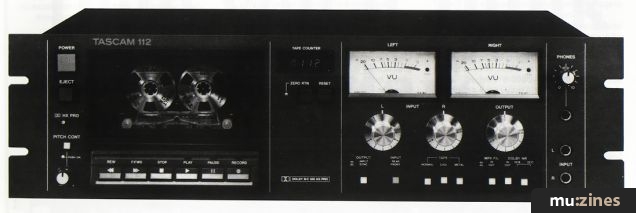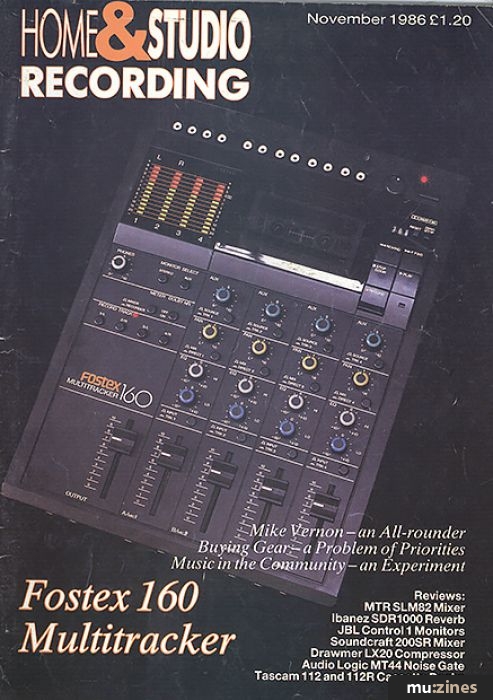Magazine Archive
Home -> Magazines -> Issues -> Articles in this issue -> View
A Pair in the Hand | |
Tascam 112 and 112R Cassette DecksArticle from Home & Studio Recording, November 1986 | |
Two decks, one basic and one sophisticated, but both offering superb performance.
These two cassette decks from Tascam would be a welcome addition to any studio or hi-fi system. The features offered by the 112R make it ideal for realtime copying whilst the more down to earth 112 seems to be more practical for general studio applications.

Tascam's 112R is a smart front-loading cassette deck that can be rack mounted simply by bolting on a pair of optional rack ears. Because it features an auto-reverse function, there are two erase heads, one for each direction, and both the record and play heads have four tracks so that they can accommodate tape travelling in either direction without having to change position. By having a separate record and play head, the 112R allows true off-tape monitoring as you record, so that you can do an instant comparison between what goes in and what comes out to verify the quality of the recording. Moreover, an optional remote control unit may be added by means of which a selection of sophisticated programme access modes may be introduced, including tune search and a useful preview feature which plays the first few bars of each song before moving to the next one. The only snag is that without the remote control unit, these facilities are impossible to access.
Unusually for a stereo cassette deck, this one is equipped with varispeed enabling the tape speed to be adjusted by up to 15% in either direction. For a musician this is useful as it allows the tape to be tuned to an instrument rather than vice versa when practising along to a tape or working out that elusive guitar solo. Also on offer is a choice of noise reduction types. When making your own recordings, you will probably either leave the noise reduction off altogether or select Dolby C. Despite the superiority of Dolby C, Tascam have kept the Dolby B option so that you can still play back your old tapes recorded to this format and also pre-recorded tapes, most of which are still Dolby B encoded.
Control Topography
In most respects the machine is straightforward to use, and despite its sophisticated internals, most of what you see on the front panel is self-explanatory. All the transport controls are soft-touch, which is only to [be] expected on a machine of this price and calibre. The only area that might require a little by way of illumination is the auto-reverse feature which can be used in record as well as play. When Reverse is selected, the machine behaves as normal until the end of the tape at which point the direction reverses and the other side of the tape is played. If set to Record, then the record mode will be held on through the direction change so that both sides of the tape may be recorded without the user intervening. When the second side of the tape is full, the transport drops out of record; it doesn't just go on and mindlessly rerecord over what you have just done. This is a very useful facility to have at your disposal if you're in the habit of recording long radio programmes during opening hours. Of course the reverse mode may be disengaged in which case the tape transport will stop at the end of each side as expected.
Direction of play is simply selected by pressing either the Forward or Reverse transport button.

In the display department there is more sophistication than you would find on the average cassette machine in that there are true peak reading bar graph level meters and a four digit illuminated tape counter. The counter operates in two user-selectable modes and displays either tape Run Time or Index Count. In Index Count, the display counts up when the tape is running forwards and down when it is running backwards so this is the most useful mode if you want to know just where you are on the tape. The counter may be cleared at any time with a reset button and there's also a memory function which is called up by simply pressing Memory Stop. When Memory Stop is active, this is affirmed by a dot indicator in the display and when the tape next passes this position, whether in play or fast wind, the transport will stop. Pressing the Memory Stop button again cancels this function.
If the optional remote is used, the display takes on other functions but, as we didn't have a remote to try out, one can only surmise that these might include track search status information.
Other features are the ones that you would expect on any high quality cassette deck. There's a choice of Normal, CrO2, or metal tape, slider input level controls and a headphone outlet, the volume of the which is regulated by the Output Level slider. There are also two mic inputs which will accept the output from most low or medium impedance microphones. In practice, these are pretty quiet and so you can make a very passable live recording just by plugging in a couple of PZMs or other appropriate mics. When a mic is plugged in, the line input is automatically muted.
The rear panel is surprisingly bare, sporting merely a pair of input and output phonos and the remote control socket.
"As both machines accept remote control, they are ideal for copying applications where several machines could be started in sync."
The Practicalities
Within the limitations imposed by the cassette format itself, this machine turns in a very favourable performance and remember, some modern cassette formulations are capable of very impressive results. Even without noise reduction, the results were surprisingly clean.
The Dolby C gives an excellent compromise between effective noise reduction and detrimental side-effects, it doesn't cause that dulling of the sound that many Dolby B machines are guilty of and yet it gives a more dramatic improvement in tape noise reduction.
Because of the reverse function and the remote programme search facility, it's my guess that this machine is aimed at the affluent hi-fi fraternity, yet a machine with these attributes would not be out of place in a studio and would be ideal for a real-time tape copying suite. If you share one machine between your studio and your hi-fi, then this may be an added incentive to choose this machine rather than one offering the basic record/play facilities.

Tascam 112
In terms of styling, this machine is similar to the 112R. However, it doesn't have the auto-reverse feature and there are differences too in the control topography department. Strictly speaking, it's a very basic but thoroughly professional 2-head machine intended for applications where it's likely to have to earn its keep. The more modest facilities are reflected in its lower cost.
Gone are the hi-fi style slider level controls and there are no mic inputs. Even so, it has one or two features absent on the 112R. Both input level controls are chunky rotary pots as is the output level control and the metering is courtesy of a couple of generously large moving coil VU meters. Because percussive sounds can be severely misrepresented by conventional VU meters, there are a couple of peak LEDs built in to give the best of both worlds.
In the noise reduction department, there is again a choice of Dolby B and C but this time the Dolby HX pro system is incorporated, the operation of which is indicated by a green LED. HX pro gives more headroom than the standard system resulting in an even better overall signal to noise ratio and less distortion on high level transients. It works by modifying the tape bias level during loud passages and the improvement in performance is worthwhile.
The front panel of the machine is designed for direct rack-mounting without the need for an adaptor kit and the transport controls are angled slightly to make them easier to use. These are all soft-touch types and the Play, Pause and Record buttons have status LEDs. The varispeed selector and control knob are to the left of the transport controls and, as with the 112R, this latter gives an adjustment of 15% in either direction. A zero return facility is built into the illuminated tape counter and the main output can be set either to monitor the input signal or the signal off-tape. In one mode, the input is always monitored whilst in the other, the monitoring automatically switches to tape-out when the machine is in play.
"By having a separate record and play head, the 112R allows true off-tape monitoring as you record..."
One practical addition is the extra pair of inputs on the front panel which come in the form of unbalanced jacks. A push-button switch allows these to be selected rather than the rear panel phono inputs.
As you might expect, there's a choice of the three main tape types, Normal, Chrome and Metal and there is an MPX filter which is useful when recording from the radio. The headphone output has its own level control and there's a socket on the rear panel to accommodate the optional remote control unit.
Conclusions
This is a very impressive pair of machines and though not cheap, they are sensibly priced when you consider that they are both built to withstand long-term professional use. For studio use, the 112 with its no-nonsense approach is probably more practical and cost-effective, but the programme search on the 112R could be useful if you need to locate tracks quickly. For those home users who wish to master on cassette rather than onto open reel, the 112 must be a good choice.
As both machines accept remote control, they are ideal for copying applications where several machines could be started in sync. In this area, the auto-reverse deck could prove particularly useful with one deck playing the master cassette and the others recording. This way you avoid having to turn the tape over. Whatever your requirements, the chances are that one of these machines will do the job.
The Tascam 112R costs £573.85 including VAT and the 112 £389.85 including VAT.
Further details can be obtained from: Harman UK, (Contact Details).
Also featuring gear in this article
Publisher: Home & Studio Recording - Music Maker Publications (UK), Future Publishing.
The current copyright owner/s of this content may differ from the originally published copyright notice.
More details on copyright ownership...
Review by Paul White
Previous article in this issue:
Next article in this issue:
Help Support The Things You Love
mu:zines is the result of thousands of hours of effort, and will require many thousands more going forward to reach our goals of getting all this content online.
If you value this resource, you can support this project - it really helps!
Donations for May 2024
Issues donated this month: 0
New issues that have been donated or scanned for us this month.
Funds donated this month: £0.00
All donations and support are gratefully appreciated - thank you.
Magazines Needed - Can You Help?
Do you have any of these magazine issues?
If so, and you can donate, lend or scan them to help complete our archive, please get in touch via the Contribute page - thanks!





